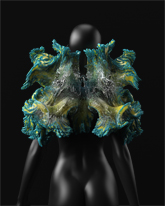 Oxman's latest pieces unveiled as part of Stratasys' collection 'The Sixth Element: Exploring the Natural Beauty of 3D Printing' on display at EuroMold, 25-28 November, Frankfurt, Germany, Hall 11, Booth FN01
Oxman's latest pieces unveiled as part of Stratasys' collection 'The Sixth Element: Exploring the Natural Beauty of 3D Printing' on display at EuroMold, 25-28 November, Frankfurt, Germany, Hall 11, Booth FN01
Stratasys Ltd. (Nasdaq:SSYS), a global leader of 3D printing and additive manufacturing solutions, today unveils Neri Oxman's latest project 'Wanderers: An Astrobiological Exploration', an ongoing collaboration between members of the Mediated Matter research group at MIT Media Lab and Christoph Bader and Dominik Kolb. The four artworks form part of a design collection that Stratasys has curated to showcase the spectacular opportunities that triple-jetting 3D printing brings to the creative design industry.
Exploring the idea of voyaging beyond planet Earth to inhabitable landscapes in the solar system, Oxman's collection is the first color, multi-material, 3D printed range of wearables aiming to embed living matter within 3D structures that augment the environment, enabling visitation to these deadly environments.
"The future of wearables lies in designing augmented extensions to our own bodies, that will blur the boundary between the environment and ourselves," explains Oxman. "With this collection, we have designed spatially and materially complex wearables pointing towards the possibility of containing living matter that can interact with the environment. Each piece intends to hold life sustaining elements contained within 3D printed vascular structures with internal cavities, made possible with the dimensional stability and high-resolution accuracy of Stratasys' 3D printing technology. Living matter within these structures will ultimately transform oxygen for breathing, photons for seeing, biomass for eating, biofuels for moving and calcium for building."
According to Oxman, the introduction of Stratasys color, multi-material 3D printing enables her team not only to customize designs specific to the individual, but empowers designers with the ability to engineer and closely control mechanical and optical material properties required for their designs:
"3D printing enables us to customize our designs and produce close to perfect-fit second skins informed by human CAT or MRI scans. The Stratasys triple-jetting technology of the Objet500 Connex3 color, multi-material 3D Production System offers designers unprecedented control over material properties such as rigidity, opacity and color at scales of just several microns. This enabled us to design for movement, as well as being able to implement spatially differentiated, layered channels, folds, pores and pockets. None of this would be possible with traditional fabrication methods."
MUSHTARI (مشتري): Jupiter's Wanderer*
Mushtari, Arabic for huge or giant, is designed to interact with Jupiter's atmosphere. This tortuous piece is designed as a single meandering strand inspired by the human gastrointestinal tract. It is a wearable that will consume and digest biomass, absorb nutrients, generate energy in the form of fuel or sucrose accumulating in the side pockets and expel waste. With triple-jetting technology, Oxman was able to 3D print the intricate, translucent tubing, as well complex layering, and produce varied degrees of flexibility for movement.
ZUHAL (زحل): Saturn's Wanderer*
This piece was inspired by, and created to adapt to the vortex storms on Saturn. It has a hairy and fiberous large surface area designed to contain bacteria that convert the planet's hydrocarbons into edible matter for humans. This geometrically complex, textural exterior is made possible with Stratasys 3D printing materials and triple-jetting technology that are malleable enough to vary in size, density and organization, accomodating for variations in anticipated wind speeds.
OTAARED (عطارد): Mercury's Wanderer*
For the planet Mercury, Oxman and her team have created a structure that acts as a protective exoskeleton for the head as the planet lacks any atmosphere. Here, Stratasys color, multi-material 3D printing enables highly accurate customized fittings to individual specifications. The resulting 3D printed shell is designed to contain calcifying bacteria within a wearable Caduceus, with the ultimate goal of growing true, organic bone structures.
AL-QAMAR (قمر): Luna's Wanderer*
Inspired by one of the most luminous objects in the sky, this piece embodies the surface qualities of the Moon. Akin to a wearable biodome, the exterior contains spatial spherical moon-shaped pods for algae-based air-purification and biofuel collection to produce and store oxygen. These highly detailed levels of spatial and material variation are only possible with Stratasys triple-jetting 3D printing technology due to its versatility of material properties from rubber to rigid, transparent to opaque, neutral to vibrantly colored and standard to biocompatible.
In addition to Stratasys, Oxman collaborated with German design duo Christoph Bader and Dominik Kolb. They designed a computional growth process that cultivates forms on the human body. Inspired by natural growth the method starts with a seed and creates shapes that adapt to their environment, which are continously expanding and refined to generate personalized wearables. As a continuation, Oxman's team is now in the process of integrating living engineered cells into the wearables for functional augmentation purposes.
Naomi Kaempfer, Stratasys Creative Director Art Fashion Design concludes, "With 3D Printing, Prof. Neri Oxman and her team take our triple-jetting 3D printing technology on an outstanding voyage in science through space, time and culture. We too believe that the future of textiles lies in designing customizable wearable extensions for our bodies that could very well need to sustain or enhance elements of our daily lives."
* The word "planet" comes from the Greek term planētēs meaning "wanderer"
www.stratasys.com